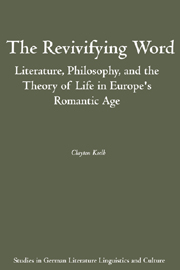Book contents
- Frontmatter
- Contents
- Preface
- Note on Abbreviations and Translations
- Part I Letter and Spirit
- Part II The Dead and Living Past
- Part III The Incarnate Word
- 7 “Eat This Scroll”: Kleist's “Michael Kohlhaas”
- 8 “I Sickened as I Read”: Mary Shelley's Frankenstein
- 9 “Those Who, Being Dead, Are Yet Alive”: Maturin's Melmoth the Wanderer
- 10 “This Hideous Drama of Revivification”: Poe and the Rhetoric of Terror
- Conclusion
- Works Cited
- Index
9 - “Those Who, Being Dead, Are Yet Alive”: Maturin's Melmoth the Wanderer
from Part III - The Incarnate Word
Published online by Cambridge University Press: 05 February 2013
- Frontmatter
- Contents
- Preface
- Note on Abbreviations and Translations
- Part I Letter and Spirit
- Part II The Dead and Living Past
- Part III The Incarnate Word
- 7 “Eat This Scroll”: Kleist's “Michael Kohlhaas”
- 8 “I Sickened as I Read”: Mary Shelley's Frankenstein
- 9 “Those Who, Being Dead, Are Yet Alive”: Maturin's Melmoth the Wanderer
- 10 “This Hideous Drama of Revivification”: Poe and the Rhetoric of Terror
- Conclusion
- Works Cited
- Index
Summary
LIKE GOETHE'S WERTHER, Kleist's Kohlhaas, and Shelley's Frankenstein, Charles Robert Maturin's gothic romance Melmoth the Wanderer (1820) exposes the demonic underside of a resurrection of the flesh and a death that brings one into life. Melmoth emphasizes the unnatural quality of a form of life that belongs to death; the novel makes the reader share in what Maturin's character Monçada calls “the horror of being among those who are neither the living nor the dead” (MM 205). In the first chapter, Old Melmoth, John Melmoth's uncle, hovers on the boundary between life and death and leads the reader into that realm of horror. He dies before the chapter is done, dies definitively and permanently, providing by means of his death the promise of an inheritance and therefore a comfortable life for his nephew. Before he dies, however, he brings up the topic of one who should have died but who lives on. In fact, Old Melmoth proposes that his death is a direct result of the living-on of that other, an ancestor depicted in an old portrait kept in a closet:
“John, they say I am dying of this and that […] — but, John,” and his face looked hideously ghastly, “I am dying of a fright. That man,” and he extended his meagre arm toward the closet, as if he was pointing to a living being; “that man, I have good reason to know, is alive still.” “How is that possible, Sir?” said John involuntarily, “the date on the picture is 1646.” “You have seen it, — you have noticed it,” said his uncle. […] “You will see him again, he is alive.” (MM 21)
- Type
- Chapter
- Information
- The Revivifying WordLiterature, Philosophy, and the Theory of Life in Europe's Romantic Age, pp. 145 - 164Publisher: Boydell & BrewerPrint publication year: 2008



